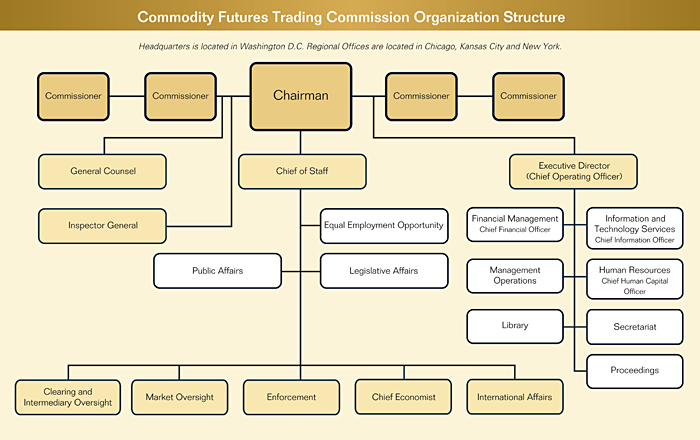Commission at a Glance: How the CFTC is Organized and Functions
The Commission consists of five Commissioners. The President appoints and the Senate confirms the CFTC Commissioners to serve staggered five-year terms. No more than three sitting Commissioners may be from the same political party. With the advice and consent of the Senate, the President designates one of the Commissioners to serve as Chairman.
The Office of the Chairman oversees the Commission’s principal divisions and offices that administer and enforce the CEA and the regulations, policies and guidance thereunder.
The Commission is organized largely along programmatic and functional lines. The three programmatic divisions—the Division of Market Oversight (DMO), the Division of Clearing and Intermediary Oversight (DCIO) and the Division of Enforcement (DOE)—are partnered with and supported by a number of offices, including the Office of the General Counsel (OGC), the Office of the Chief Economist (OCE), the Office of International Affairs (OIA), the Office of the Inspector General (OIG), and the Office of the Executive Director (OED).
The Executive Director, by delegation of the Chairman, serves as the Chief Operating Officer (COO) directing the effective and efficient allocation and use of resources, and developing the management and administrative policy and programs of the Commission.
Attorneys across the CFTC’s divisions and offices represent the Commission in administrative and civil proceedings, assist U.S. Attorneys in criminal proceedings involving violations of the CEA, develop regulations and policies governing clearinghouses, exchanges and intermediaries, and monitor compliance with applicable rules. In response to the globalization of the derivatives markets, attorneys represent the CFTC internationally in multilateral regulatory organizations and in bilateral initiatives with individual foreign regulators. Commission attorneys also participate in country dialogues organized by the U.S. Department of the Treasury. Much of the Commission’s legal work involves complex and novel issues.
Auditors, risk analysts, trade practice analysts and attorneys examine records and operations of derivatives exchanges, clearinghouses and intermediaries for compliance with the provisions of the CEA and the Commission’s regulations. Derivatives trading investigators and specialists perform regulatory and compliance oversight to detect potential fraud, market manipulations and trade practice violations. Risk analysts also perform analyses, which include stress testing, to evaluate financial risks at the trader, firm and clearinghouse levels.
Economists and analysts monitor trading activities and price relationships in derivatives markets to detect and deter price manipulation and other potential market disruptions. These analysts also monitor compliance with position limits. Economists and analysts evaluate filings for new derivatives contracts and amendments to existing contracts to ensure that they meet the Commission’s statutory and regulatory standards. Economists also analyze the economic effect of various Commission and industry actions and events, evaluate policy issues and advise the Commission accordingly.
The CFTC is headquartered in Washington, D.C., with regional offices in Chicago, Kansas City, and New York.




